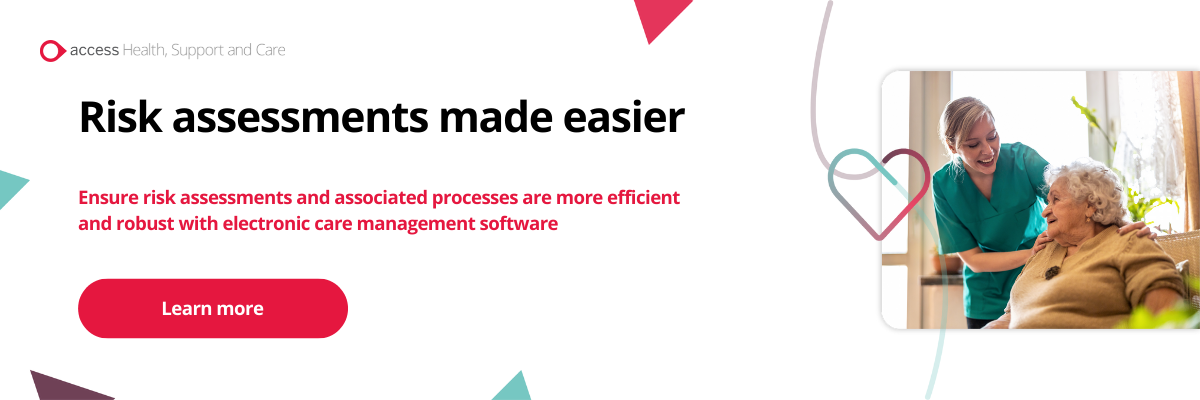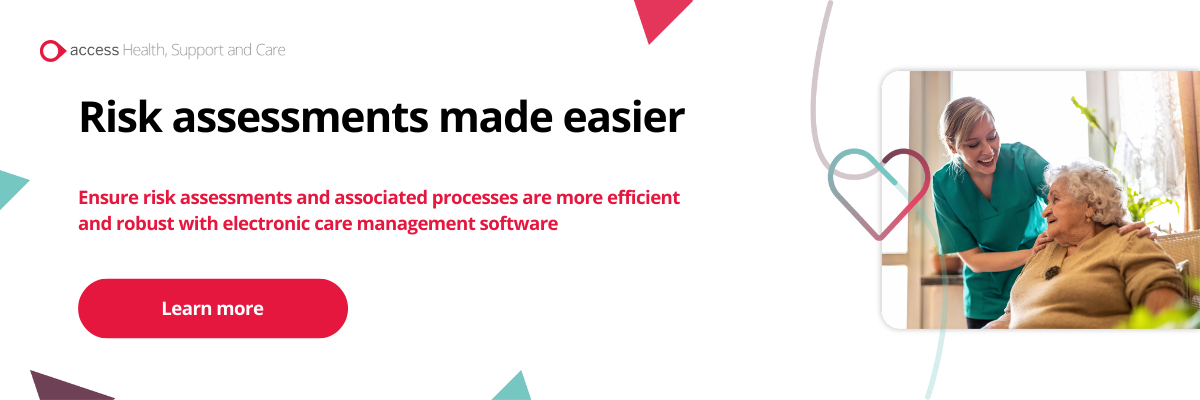Risk assessment in health and social care
Assessing where risks may exist and taking appropriate steps to prevent them is especially important in health and social care. Unlike some other aspects of regulation of health and social care in the UK, it’s a legal requirement to properly carry out risk assessments.
Failing to do so for any location or service user won’t just see your rating drop (from the CQC or Care Inspectorate etc), it could see you prosecuted under the law and/or heavily fined.
Why risk assessment in health and social care matters
In 2017 a care provider in Croydon was fined £45,000 and ordered to pay over £14,000 in costs in 2017, when a 72-year-old resident of their care home was severely burned after sitting on a portable heater [1].
In 2018, the Care Quality Commission (CQC) prosecuted a nursing home and its registered manager after a resident died after falling from a second-floor window. The provider was fined £16,500 for failing to take measures to prevent falls from windows [2].
The registered manager was fined £1000 for failing to have an up-to-date risk assessment. If they had conducted an up-to-date risk assessment, and done so properly, they may have noticed the window in question did not have restrictors fitted. They could have fitted appropriate devices and prevented the person’s death, anguish for their family and for all involved.
In all these cases and countless other examples, the courts, CQC or HSE (Health and Safety Executive) were able to show a lack of risk assessments, or risk assessments that had not been updated or conducted properly. This led to avoidable risks not being prevented and caused people to be harmed.
This blog covers the fundamentals of risk assessment in health and social care, to ensure you avoid mistakes like those above, and their serious and all too commonplace consequences.
What is a risk assessment in health and social care?
A risk assessment in health and social care is intended to protect service users and staff from harm. Care providers should carry out risk assessments for each person you provide care for, whether that’s in residential settings like a care home or in a person’s own home.
Risk assessments in health and social care must be carried out by staff that are competent to do so. A risk assessment needs to be completed before the care package commences. Risk assessments in health and social care should be updated any time a new risk is identified.
Some risks will be common. For example, fire risks in a care home, while others will be specific to individual service users or members, such as the risk of falling out of bed.
Electronic care planning systems typically come ready with pre-built risk assessments, including general risk assessments and those for specific areas (such as falls risk assessments). Depending on the system these electronic risk assessments can be modified and configured to suit your specific requirements, or match your existing processes.
Workflow is often built into such systems, so that follow up actions from risk assessments, automated reminders to conduct risk reviews and so on can be automatically progressed and tracked more easily, to ensure they actually happen and do so in a timely manner.
Balancing risk prevention with other priorities
A risk assessment in health and social care should consider ‘all reasonable risks’, what the Health and Safety Executive define as ‘Sensible risk assessment in care settings.’ This means balancing decisions to prevent risk, with helping the person to live a full life and move towards their goals.
They should be mechanisms to help people live fulfilled lives safely, rather than restricting their freedom. Providers should not be too risk averse but should be sensible.
Examples of risk assessments in health and social care
In its simplest form a risk assessment can sit on a spreadsheet or table, based on the steps above:
- Column 1: What’s the risk? To whom?
- Column 2: How likely is harm to occur and what is the severity of harm?
- Column 3: Control measures/actions required (with record of who took the action and on what date)
- Column 4: Further/ongoing actions required
The risk assessment should include:
- Name of the person that carried out the assessment
- Location of assessment
- Date of the assessment
- Signature
- Date of next review
How to carry out health and social care risk assessments
Here is a process you can follow to carry out risk assessments in health and social care:
Step 1: Gather information to identify risks and hazards
Hazards in a care home for example will typically be identified during a thorough inspection of the care premises.
Step 2: Determine who might be harmed and how (staff/service users/others/all)
Its important to record not just the groups that are at risk of harm, but how each group is specifically at risk. For example, in moving and handling or equipment use, risk is caused to service users and staff in different ways.
Step 3: Evaluate the risks and identify possible controls to mitigate those risks
It's important to evaluate:
- How likely it is that harm will occur?
- How serious could the harm be?
- What steps are already being taken to control the risk?
- What further action should be taken to control the risk?
- Who needs to carry out those actions?
- When the action needs to be taken by?
Some organisations employ a scale or other system to assign a score to each risk/hazard based on likelihood and severity, such as measure of likelihood multiplied by severity and categorised as high, medium or low or on a 1-10 scale.
There is no compulsory scale or method however, so use whichever method seems most effective at helping to detect and prevent risk in your organisation, you may also want to consult other care providers to see what system works best for them.
Step 4: Deciding on control methods
Wherever possible, eliminating a risk is always the best option. For example, removing a trip hazard, securing that loose carpet, modifying processes, agreeing new ways of delivering care to a person etc.
Existing controls in place must be checked to see if they are adequate and/or compliant with any specific legal requirements or standards. The Health and Safety Executive advises to check control methods (and any new proposed control methods) against best practice.
When preventing risks to service users it's important to bear in mind choice. Always consult and ensure you are prioritising person centred care when selecting control methods.
Employers in care are required to do all they can to reduce risks that is “reasonably practicable.” This means balancing level of risk against the cost, time or trouble of control methods.
Step 5: Record your findings, implement control methods
Risk assessments should be shared with appropriate people in your organisation. The risks identified along with the control methods for them should feed into the person’s care plan. Of course, any actions that need to be taken should be carried out.
Step 6: Review and update the risk assessment if needed
Risk assessments in health and social care need to have a built in review date. Risks that are judged to be severe/high level with greater harm potential should be reviewed more frequently. New assessments should be made whenever existing hazards change or new risks are identified.
Examples of common risk areas in health and social care
The areas that feature most commonly in health and social care risk assessments include:
- Moving and handling – responsible for a significant proportion of accidents in health and social care
- Medication handling
- Slips/trips
- Challenging behaviour/violence or aggression
- Food risks (allergies, choking, burns, preparation risks etc.)
- Infection prevention (including COVID-19)
In specific environments such as for risk assessments in care homes, the following are also common:
- Scalding and burning, from heating apparatus or bathing for example
- Electricals, asbestos, fire and other premises based risks that affect everyone
- Bedrail entrapment
- Legionella
- Staffing levels – more information on safe staffing levels in care homes.
For more information on risk assessments in social care, there are detailed resources via the Health and Safety Executive.
[1] Care Quality Commission, 'Nursing home prosecuted by CQC over serious burns injury' Published: 20/10/2017. Accessed 20/02/2022
[2] Care Quality Commission, 'Learning Safety Issue 7: Falls From Windows' Published: 08/01/2019. Accessed at 20/02/2022


